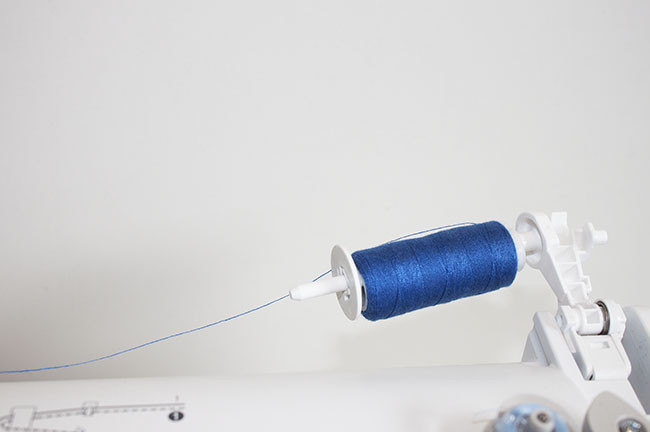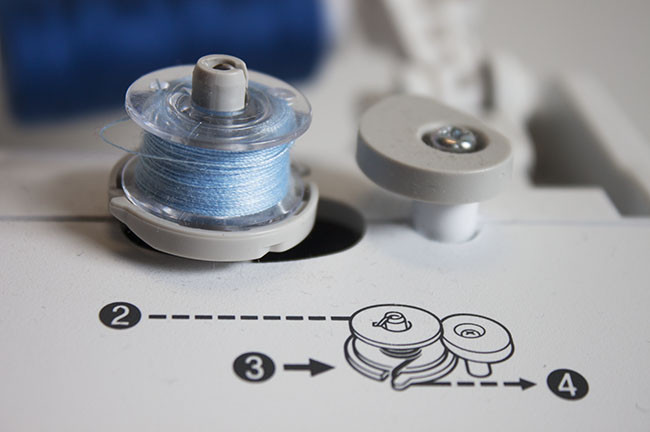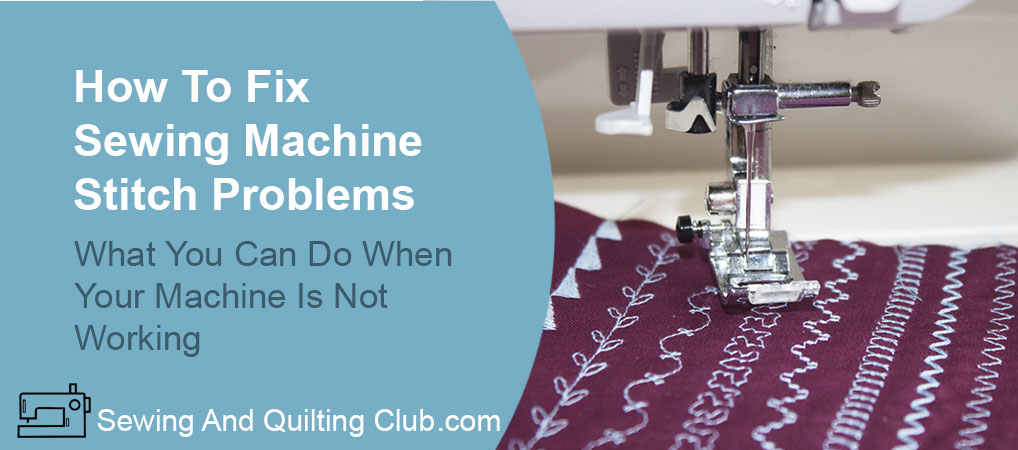Fix Sewing Machine Stitch Problems will help you to know better about your machine and it will work great to help you to work on many different sewing projects.
Fix Sewing Machine Stitch Problems
When you just begin to sew, there will be sometimes when your sewing will not be working at all, you might get frustrated wondering what is the problem!
Many times you might be thinking that your sewing machine is broken or this might not be a good quality machine and it just doesn’t work at all!
Believe me, I was there and I guess many advanced sewers can join me to share a few stories when they began and when their sewing machine was not working at all.
 I remember one day I had to call the sewing machine technician because my sewing machine was not working at all and I didn’t know what to do at all.
I remember one day I had to call the sewing machine technician because my sewing machine was not working at all and I didn’t know what to do at all.
The technician, a very gentle man, listened to me with patience, then he smiled and told me: – Let’s take a look to your machine, he sat in front of the machine, he took a look at it, he just did a couple of things to the machine and 5 minutes later, he told me, – Give it a try.
My sewing machine was working great as day 1!
Then he told me, most of the times, he used to get calls from sewers who were having big problems with their sewing machines, but most of the time those problems were easy problems to fix, and he took the time to teach me a few tricks to thread correctly my sewing machine and to set the thread tension right to keep the machine in perfect conditions most of the time.
From that day, I’ve been working with a few different sewing machines, without the need to call him back again!
Today I will share some tips on how to keep your sewing machine stitching great for you.
How To Fix Sewing Machine Stitch Problems
Most Common Sewing Machine Stitch Problems.
It’s often common for beginner sewers to face some problems on their sewing machine:
- You’re sewing machine keeps jamming
- Stitching tension is not right and it’s looping on the bottom or on the top side of the fabric
- Thread is bunching up
- Thread keeps breaking
- Your machine keep skipping stitching
I know how frustrated you can feel when you plan to work on a project and you can’t work on it as your machine is not working good at all.
Every beginner sewer and some with some experience will face one or two of these problems as they work on a new project.
Learning more about your sewing machine, will help you know how to set it up for different projects, and what type of needle and thread to use it.
Let’s take a look to a check list that will help you to set up your sewing machine to work on every project and get the best of results.

Correct Threading
If you use the same type of thread on most of your projects, all you need to do is to follow the instructions and numbers printed on top of your machine to thread it correctly.
If you notice your machine is skipping stitches or breaks the thread, you might need to thread again the machine as it’s easy to skip one step while you do it. Many times you will find after threading the machine again, it works great.
It’s often common to get so used to your machine and you will get used to the steps to follow to thread it correctly and you will get fast at doing it correctly. In case you buy a new model or a different brand, take your time to read the manual to know if there is a particular threading to each model and brand. Most sewing machines are designed with similar steps, but it’s always better to read the manual first.
After you have threaded your machine and still not getting stitching quality, you can read your machine’s manual to see if you are following the right steps for this particular model.
Use The Right Type Of Needle
Many times while sewing different types of fabric, you might notice your machine will start giving you some problems as skipping some stitches or even damaging the fabric.
If you use most of the time the same type of fabric, you might not see this problem happening as you work on your projects, but if you switch from different types of fabric while you work on different projects or on the same project, you might have the wrong type of needle for a particular type of fabric.
You’re sewing machine will come from the manufacturer with a set of regular sewing machine needles, if you’re working with fabrics like cotton, rayon or polyester, you might not see any problem as you keep working with a regular sewing machine needle.
If you notice some problems when you use knit fabric to make a project, you need to change your sewing machine needle, for a ball point needle, these needles have a round point that will go through the knitted fabric without making any damage into the fabric and you will get a better stitching quality on your projects.
The same will happen when you work when you use a thin fabric or an open woven fabric, you need the right sewing machine needle to get always a professional finish on all your projects.
Bonus: When I was working for a big factory making small clothing for a well-known doll, a person from this factory in charge of quality control told me: When you don’t know what type of needle you need to have in your sewing machine, it’s better to have always a ball point needle, it will save you a few headaches and will help you to make more money from your sewing. It worked great for me!

Use The Right Type Of Bobbin For Your Sewing Machine
Sewing machine manufacturers from every well-known brands around the world, design every model to help every sewer to get the best results from their sewing on every projects.
When they design every model, they also design every part of your sewing machine, and when we talk about bobbins, every sewing machine needs to work with the bobbin type for it.
You can find on the market a few different types of bobbins, your sewing machine comes from the manufacturer with 3 or 4 bobbins as part of the accessories that comes with it.
As you keep sewing, you might like to have more than 3 or 4 bobbins with thread to help you to work with ease on every project.
Be sure to purchase the same type of bobbin for your sewing machine. This will save you some problems later.
Bonus: In case you own two or more sewing machines, take your time to check what type of bobbin each machine uses, in case you have two or more sewing machines that use different type of bobbins, you always can mark all the bobbins differently so you don’t get confused. Add a small dot of different color paint on each bobbin to know which bobbin goes with which machine.
Use The Best Thread For Each Project
There are in the market a good amount of different threads you can use on your sewing machine, but not all are the same. As you keep sewing, you will learn about the difference between them and soon you will have at home a good number of different threads to use on your projects.
Different type of projects and fabric will require to use a different thread to get better results, when you learn to sew, you will be learning about different types of fabric and what thread is used with each one of them, this will help you to get better results on every project.
I know, some threads will have a high cost, but it is worth it, as soon as you use them on your next project, you will see how well your machine works and you will notice how well it goes as you work on your project.
Soon you will get a box full of different threads for your sewing machine, you can always make some notes on your sewing planner or you can add a note on a tape to each thread spool (inside) this way you will know what thread to use with what type of fabric.
Some threads can get old and this will give you some problems of thread breaking often as you work on a project, if this happens, it is not your sewing machine, but the thread.
Learn To Set Tension On Your Sewing Machine
As you learn to sew, you will be working with different type of fabrics and thread, this will give you some problems as you start working on your project.
Learning to set tension on your sewing machine is a matter of practice, don’t be afraid to set the dial for the stitching tension on your machine, you always can take a note of what tension you have on your machine, before you start moving the dial one number higher or lower, this will help you to put back your machine to the numbers on the dial you had when you started to work with it.
As you get better results setting stitching tension on your machine, always make some note of the numbers and the results for each project you worked on, this will help you find how to set your machine faster anytime you need to work with the same type of fabric.
Bonus: When working on a project where you need to set tension on your machine, always make a test run with a scrap of some fabric so you can check on the stitching quality before you start working on your project. Make all the adjustments you need to do until you are happy with the stitching.
Maintenance Will Keep Your Sewing Machine On It’s Best
You’re sewing machine requires a good maintenance and you can do it by yourself, only if you own a very specialized machine, then you need to call the technician to do a maintenance program on it)
Keeping your machine clean and well lubricated will help you to get the best stitching quality from it, and it will also help to keep your machine in good shape and last for many years or hours of stitching.
You’re sewing machine is an investment on your hobby or on your business, taking some time to do a good cleaning and checking on its parts will help you to keep it on its best as you work on different projects.
If you do a regular maintenance on your machine, don’t forget to unplug it before you start cleaning the machine.
As you work on your projects, your machine will get some lint inside and this can give you some problems to get a good stitching quality, you will notice your machine will give you good quality of stitching as soon as your remove any lint from it.
If you’re a quilter and you do Free Motion Quilting, you need to clean your machine after you finish each quilt.
Fix Sewing Machine Stitch Problems Closing Thoughts
 As you get to know your sewing machine, as each model is different, you will know more about what thread is better to use and how to thread your machine.
As you get to know your sewing machine, as each model is different, you will know more about what thread is better to use and how to thread your machine.
Sewing machines are designed to work great on different projects and to last for many years and hours of use, your sewing machine is an investment that will help you to sew many different projects, whether you sew as a hobby or as a business, the time you put into learning more about your machine is well worth it and it will help you to avoid any of the most known stitch problems any sewer will get in their sewing machine.
I hope you find this post helpful and that it will help you to solve any easy problem you face today with your sewing machine. If your machine is making any noise it shouldn’t be doing or not working at all, it’s always better to know the technician, they will know what to do to make your machine to work great again.
At last, always remember to unplug the machine before taking a look to it to fix any problem.
I’m sure if you follow these tips your machine will last for many years in your sewing room – Happy Sewing!
You can also read:
- How To Use A Sewing Machine – A few tips to help you to know how to use your sewing machine any beginner will love to know.


HI, Alex. This is so informative. My grandma was a pioneer in sewing colored plastic raincoats in our town. I used to watch her sew lots of different garments too, when I was young.
I never knew that sewing machine needs to have the right thread, needle or bobbins. I thought there’s a universal/generic thread and needle for all types of sewing machine.
Thanks for sharing this post.
Ruth